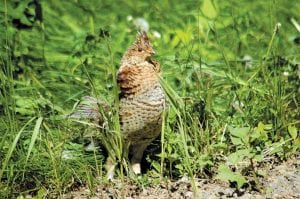Minnesota’s ruffed grouse spring drumming counts are significantly higher than last year across most of their range, according to a report released by the Minnesota Department of Natural Resources (DNR).
“Counts have been increasing steadily since 2005, but this is the substantial annual increase we’ve been hoping for,” said Mike Larson, DNR research scientist and grouse biologist. “Drumming counts this year are as high as counts during recent peaks in the population cycle.”
Ruffed grouse populations, which tend to rise and fall on a 10-year cycle, are surveyed by counting the number of male ruffed grouse heard drumming on established routes throughout the state’s forested regions.
This year observers recorded 2.0 drums per stop statewide. Last year’s average was 1.4 drums per stop. Counts vary from about 0.8 drums per stop during years of low grouse abundance to about 1.9 during years of high abundance.
Drumming counts increased 44 percent over those during 2008 in the northeast survey region, the core and bulk of grouse range in Minnesota, to 2.4 drums per stop. Grouse counts increased most in the northwest region, from 0.9 to 1.9 drums per stop. Counts of 1.1 drums per stop in the central hardwoods and 0.5 drums per stop in the southeast were similar to last year’s counts.
Minnesota frequently is the nation’s top ruffed grouse producer. On average, 115,000 hunters harvest 545,000 ruffed grouse in Minnesota each year, also making it the state’s most popular game bird.
During the peak years of 1971 and 1989, hunters harvested more than one million ruffed grouse. Michigan and Wisconsin, which frequently field more hunters than Minnesota, round out the top three states in ruffed grouse harvest.
“Higher drumming counts are good news,” said Dennis Simon, DNR wildlife section chief. “Minnesota offers some of the best ruffed grouse hunting in the nation and we want to maintain and enhance those opportunities.”
One reason for Minnesota’s status as a top grouse producer is an abundance of young forest and other ruffed grouse habitat, much of it located on county, state and national forests, where public hunting is allowed. An estimated 11.5 million of the state’s 16.3 million acres of forest are grouse habitat.
For the past 60 years, DNR biologists have monitored ruffed grouse populations. This year, DNR staff and cooperators from 15 organizations surveyed 132 routes across the state.
The DNR’s 2009 grouse survey report, which contains information on ruffed grouse and sharp-tailed grouse, is available online at www.mndnr.gov/hunting/ grouse.



Loading Comments